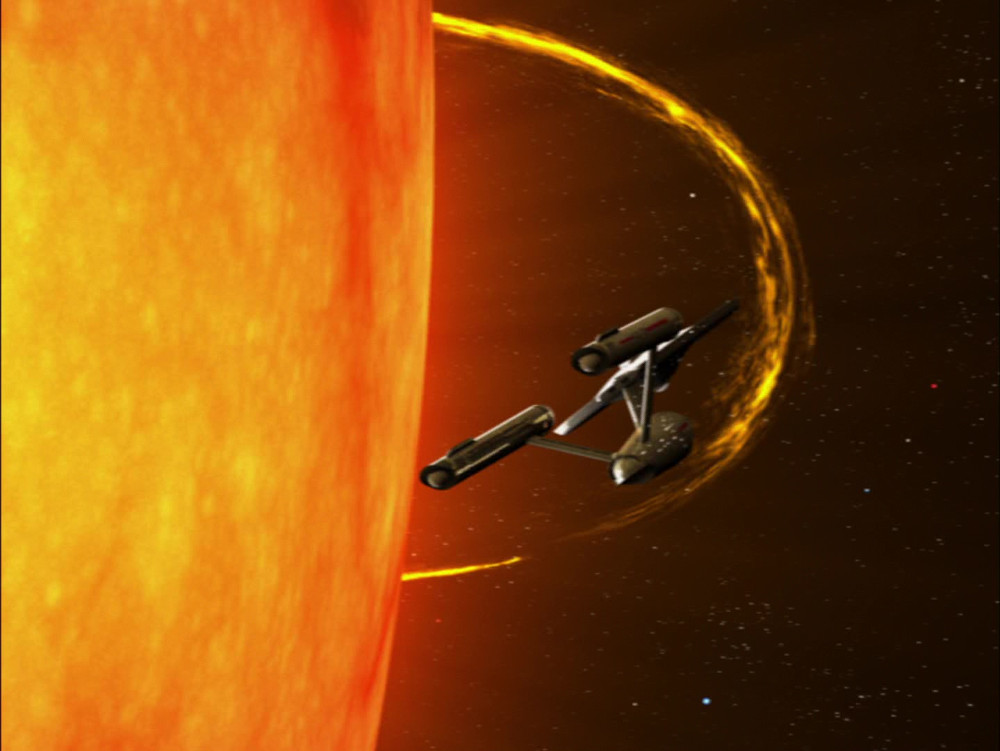Difference between revisions of "time travel"
(Created page with "{{ImageInfoBox2|name=time travel|file=time_travel-tos21.jpg|caption=Time travel via the lightspeed breakaway maneuver (TOS Tomorrow is Yesterday (Episode)...") |
m |
||
| Line 3: | Line 3: | ||
{{TableRow|title=Advertising|data={{AmazonLinkTOSBD}}}} | {{TableRow|title=Advertising|data={{AmazonLinkTOSBD}}}} | ||
|}</div> | |}</div> | ||
| − | Time travel was the act of traveling through time. On [[Stardate]] [[2266#1704|1705.0]], the [[U.S.S. Enterprise NCC-1701|U.S.S. ''Enterprise'' NCC-1701]] accidentally traveled through time three [[days]] into the past by forcing a cold-restart of the ship's [[warp drive|warp engines]] while orbiting [[Psi 2000]], which was undergoing enormous changes in its [[mass]] and [[gravity]].<ref name="TOS06"/> On Stardate [[2267#SD3113|3113.2]], the ''Enterprise'' was en route to Starbase 9 when it encountered an uncharted [[black hole|black star]]. The [[singularity]]'s high gravity required the ship to use all of its power to escape, inadvertently throwing the ship into a [[time travel|time warp]] that deposited it in [[1969]].<ref name="TOS21"/> | + | Time travel was the act of traveling through time. On [[Stardate]] [[2266#1704|1705.0]], the [[U.S.S. Enterprise NCC-1701|U.S.S. ''Enterprise'' NCC-1701]] accidentally traveled through time three [[days]] into the past by forcing a cold-restart of the ship's [[warp drive|warp engines]] while orbiting [[Psi 2000]], which was undergoing enormous changes in its [[mass]] and [[gravity]].<ref name="TOS06"/> On Stardate [[2267#SD3113|3113.2]], the ''Enterprise'' was en route to Starbase 9 when it encountered an uncharted [[black hole|black star]]. The [[singularity]]'s high gravity required the ship to use all of its power to escape, inadvertently throwing the ship into a [[time travel|time warp]] that deposited it in [[1969]]. The ship was able to reproduce this effect,<ref name="TOS21"/> dubbed the lightspeed breakaway method,<ref name="TOS55"/> in order to return to [[2267]]. A year later, the ship's crew would utilize this method again to travel to [[1968]] in order to conduct historical research.<ref name="TOS55"/> |
{{References}} | {{References}} | ||
<references> | <references> | ||
<ref name="TOS06">{{RefTOS06}}</ref> | <ref name="TOS06">{{RefTOS06}}</ref> | ||
<ref name="TOS21">{{RefTOS21}}</ref> | <ref name="TOS21">{{RefTOS21}}</ref> | ||
| + | <ref name="TOS55">{{RefTOS55}}</ref> | ||
</references> | </references> | ||
[[Category:Library]] | [[Category:Library]] | ||
Revision as of 22:02, 6 February 2022
| First Appearance | TOS 06 (29 Sep 1966) |
| Advertising |
Time travel was the act of traveling through time. On Stardate 1705.0, the U.S.S. Enterprise NCC-1701 accidentally traveled through time three days into the past by forcing a cold-restart of the ship's warp engines while orbiting Psi 2000, which was undergoing enormous changes in its mass and gravity.[1] On Stardate 3113.2, the Enterprise was en route to Starbase 9 when it encountered an uncharted black star. The singularity's high gravity required the ship to use all of its power to escape, inadvertently throwing the ship into a time warp that deposited it in 1969. The ship was able to reproduce this effect,[2] dubbed the lightspeed breakaway method,[3] in order to return to 2267. A year later, the ship's crew would utilize this method again to travel to 1968 in order to conduct historical research.[3]
Notes and References
- ↑ Roddenberry, Gene (Executive Producer). "The Man Trap". Star Trek, season 1, episode 1 (Production number 06). Directed by Marc Daniels. Written by George Clayton Johnson. Desilu Productions. 8 September 1966.
- ↑ Roddenberry, Gene (Executive Producer). "Tomorrow is Yesterday." Star Trek, Season 1, Episode 19 (Production 21). Directed by Michael O'Herlihy. Written by D.C. Fontana. Desilu Productions, 26 January 1967.
- ↑ 3.0 3.1 Roddenberry, Gene (Executive Producer/Story). "Assignment: Earth." Star Trek, Season 2, Episode 26. Directed by Marc Daniels. Story by Gene Roddenberry & Art Wallace. Teleplay by Art Wallace. Desilu Productions, 29 March 1968.

